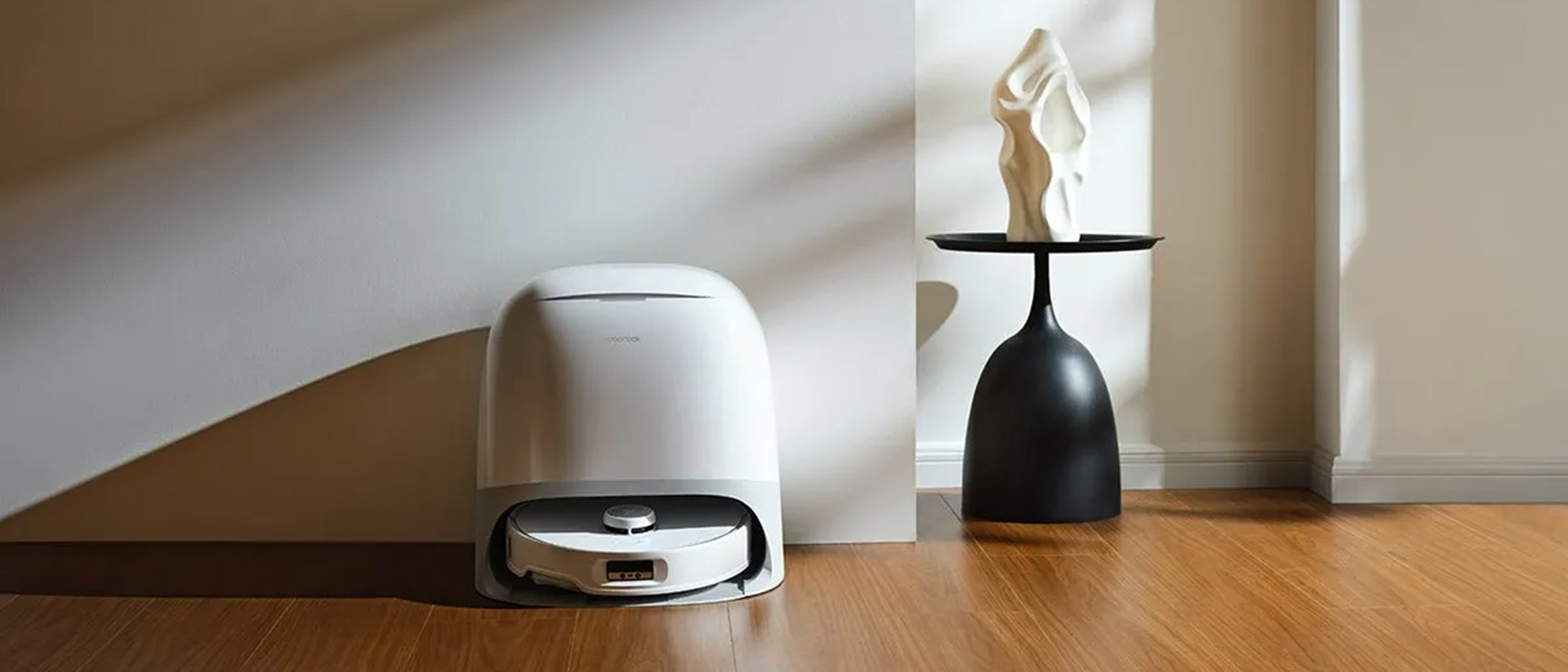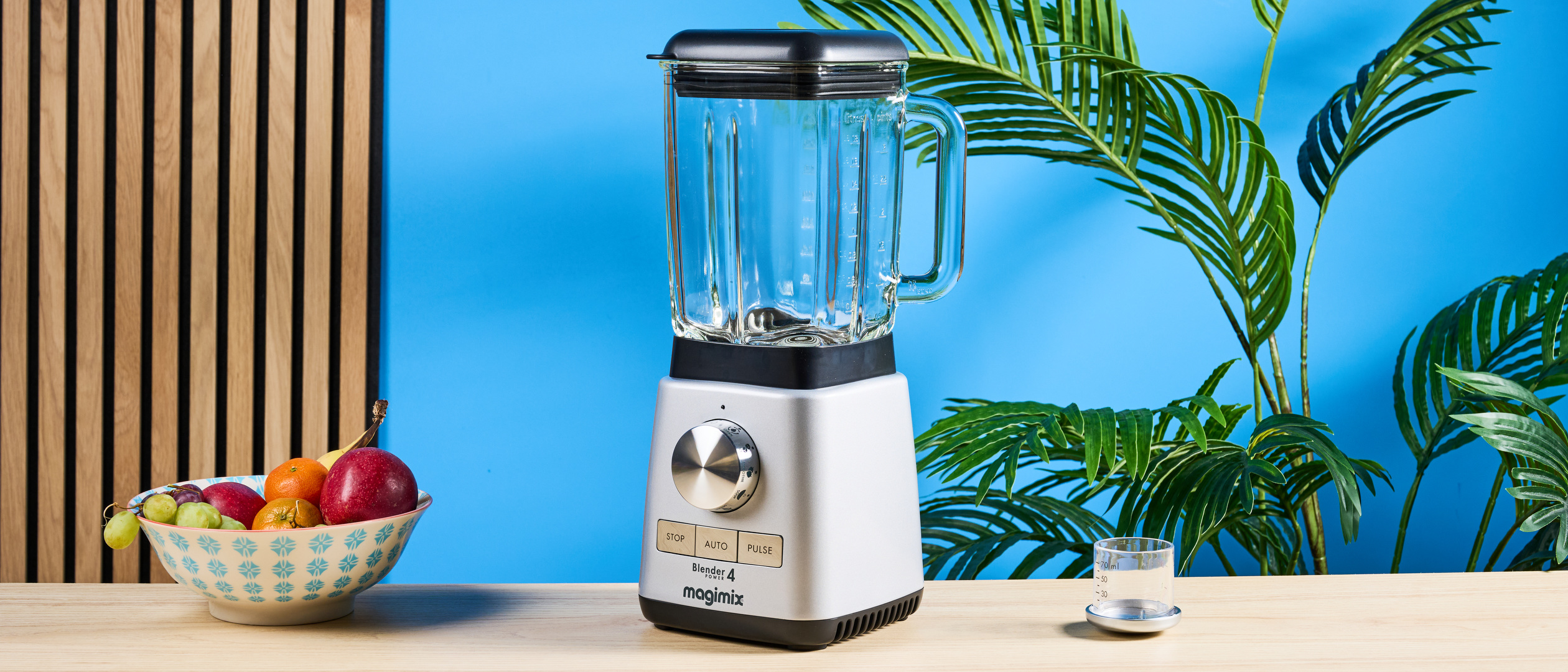Tom's Guide Verdict
The Roborock Qrevo Curv is a very intelligent robot vacuum and mop, and did a thorough job on both hardwood and carpets. However, it wasn’t the best at picking up pet hair on rugs, and it costs a good deal more than robot vacuums such as the Shark PowerDetect 2-in-1, which has similar features — and better performance in some cases.
Pros
- +
Huge suction power
- +
Stunning hardwood performance
- +
Extending arms for better reach
- +
App works very well
Cons
- -
Very expensive
- -
Struggles to pick up pet hair on a carpet
Why you can trust Tom's Guide
Overall cleaning performance: 94.5
Pet hair score: 83.6
Self-emptying dock: Yes
Suction power: 18,500 Pa
Keep-out zones: Yes
Obstacle avoidance: Yes
Bin size: 0.3 liters
Smart home compatibility: Google Home, Amazon Alexa, Siri Shortcuts
Size: 13.9 x 13.7 x 4.1 inches
Weight: 8.6 pounds
On board dustbin capacity: 0.3 liters
Roborock is on a robo-roll. Over the past few years, the company has solidified its status as one of the best robot vacuum makers out there, building powerful and versatile products that boast a range of helpful features. One of the latest of these is the Roborock Qrevo Curv, which is designed with a more elegant design and docking station – but also offers some of the better performance we’ve seen from one of the best robot mops.
But apparently, elegance comes at a price. The Qrevo Curv is one of the more expensive robotic vacuums out there right now, approaching the price of its most powerful model, the S8 MaxV Ultra. Does the Roborock Qrevo Curv do enough to justify its price tag, or should you save your cash and go for an alternative?
Roborock Qrevo Curv review: Price and availability
The Roborock Qrevo Curv is available right now from the Roborock website or Amazon. It is priced at $1,599.99, which isn't quite as expensive as the $1,799.99 S8 MaxV Ultra, but it's still up there compared to the majority of robotic vacuums. Unlike some of Roborock’s other robotic vacuums, it’s only available in white.
Roborock Qrevo Curv review: Design
The Roborock Qrev Curv is more elegant than other robotic vacuums, largely through the design of the docking station. Seemingly, the vacuum gets its name from the shape of the dock, which looks kind of like a little igloo rather than a blocky cube typical of other robotic vacuums. Instead of showing all the separate bins for clean water, dirty water, and dirt, there's a lid that hides them all, which you can easily open up to remove the bins. I quite like the look, though it's not quite as space-efficient as other vacuums. Additionally, it's relatively wide, even wider than the Roborock S7 MaxV Ultra. The docking station is a perfect cube of 17.7 dimensions in every direction – though it’s not shaped like a cube, of course.
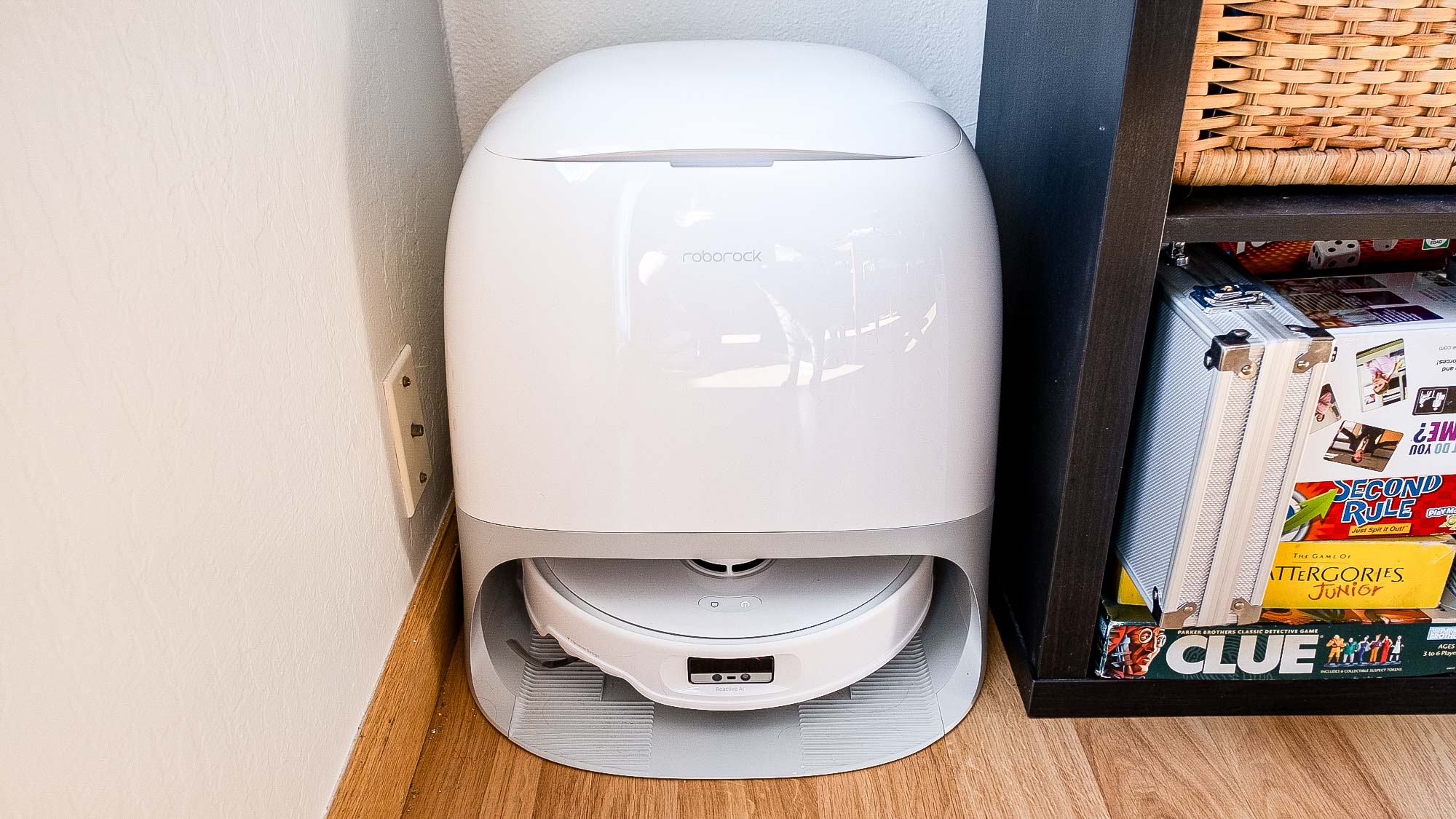
The dock is one of the more advanced robotic vacuum docks out there. Like Roborock's other premium products, the dock can hold clean water for the vacuum's mopping feature and to clean the mop pads on the device. There's a dirty water tank that will fill up as it cleans the mop pads, and a large dustbin that the vacuum will empty into after each clean. As the docking station cleans the mop pads, it will use built-in scrapers that ensure any debris is completely removed. Over time, this will get dirty, which is to be expected, but you can remove this section of the base station so that you can manually clean it.
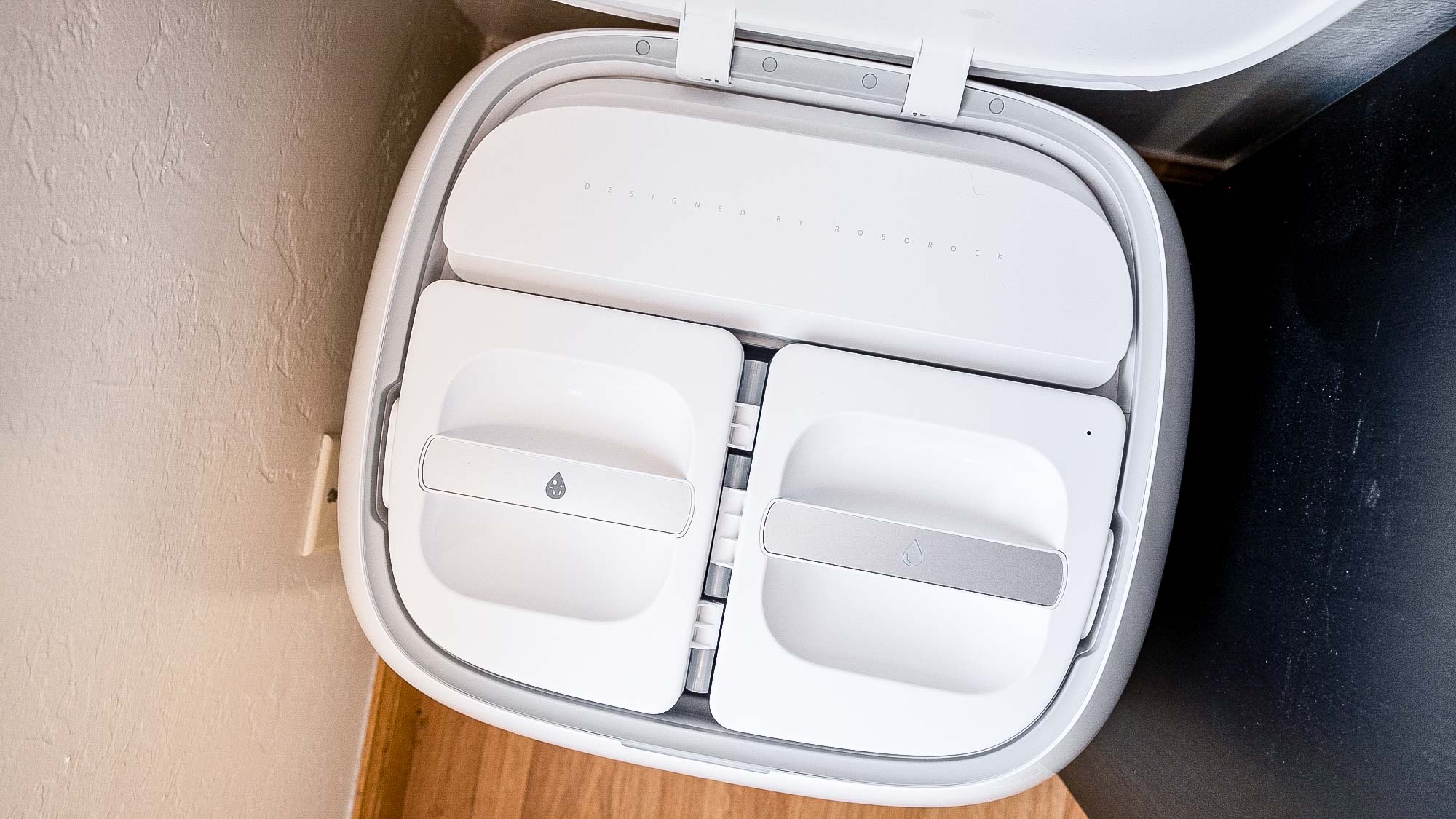
Less unique than the docking station is the design of the vacuum itself. At first glance, it just looks like any other robotic vacuum, and if you've seen any of Roborock's other products, you'll immediately recognize the design. That said, there are a few design elements that help make this model stand out. Like some other premium robotic vacuums, the Qrevo Curv has two spinning mop pads on the bottom rather than a stationary mop pad, as can be found on most other hybrid robot vacuums. These mop pads can extend out from the body of the vacuum to better mop edges, though given the fact that they're round, they won't completely get into square corners. The side brush can be extended too, and because it's flexible, it will be able to get into corners.
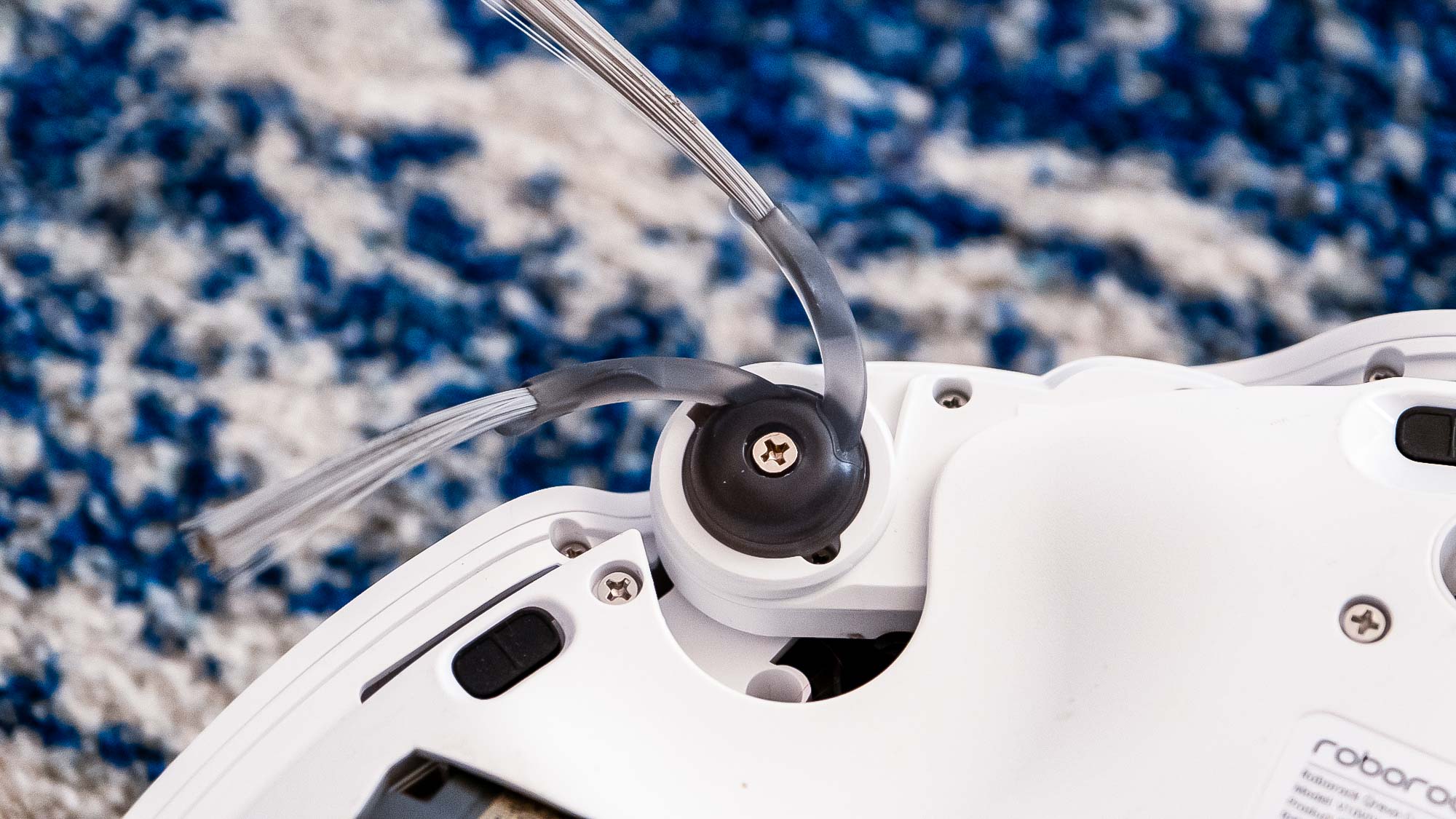
Similar to Shark’s “NeverStuck” feature is Roborock's new AdaptiLift chassis, which allows the vacuum to lift its entire body by 0.4 inches to help it get over certain obstacles, like taller thresholds. I don't have many tall obstacles that I want a robotic vacuum to scale, but I do have a shorter threshold between the hallway and the bathroom where the floor changes from wood to linoleum. While previous robotic vacuums I've owned were able to scale this relatively easily, I found the Curv to be able to do so with a little less rattle and movement. Roborock says that the vacuum can scale thresholds up to 1.6 inches tall.
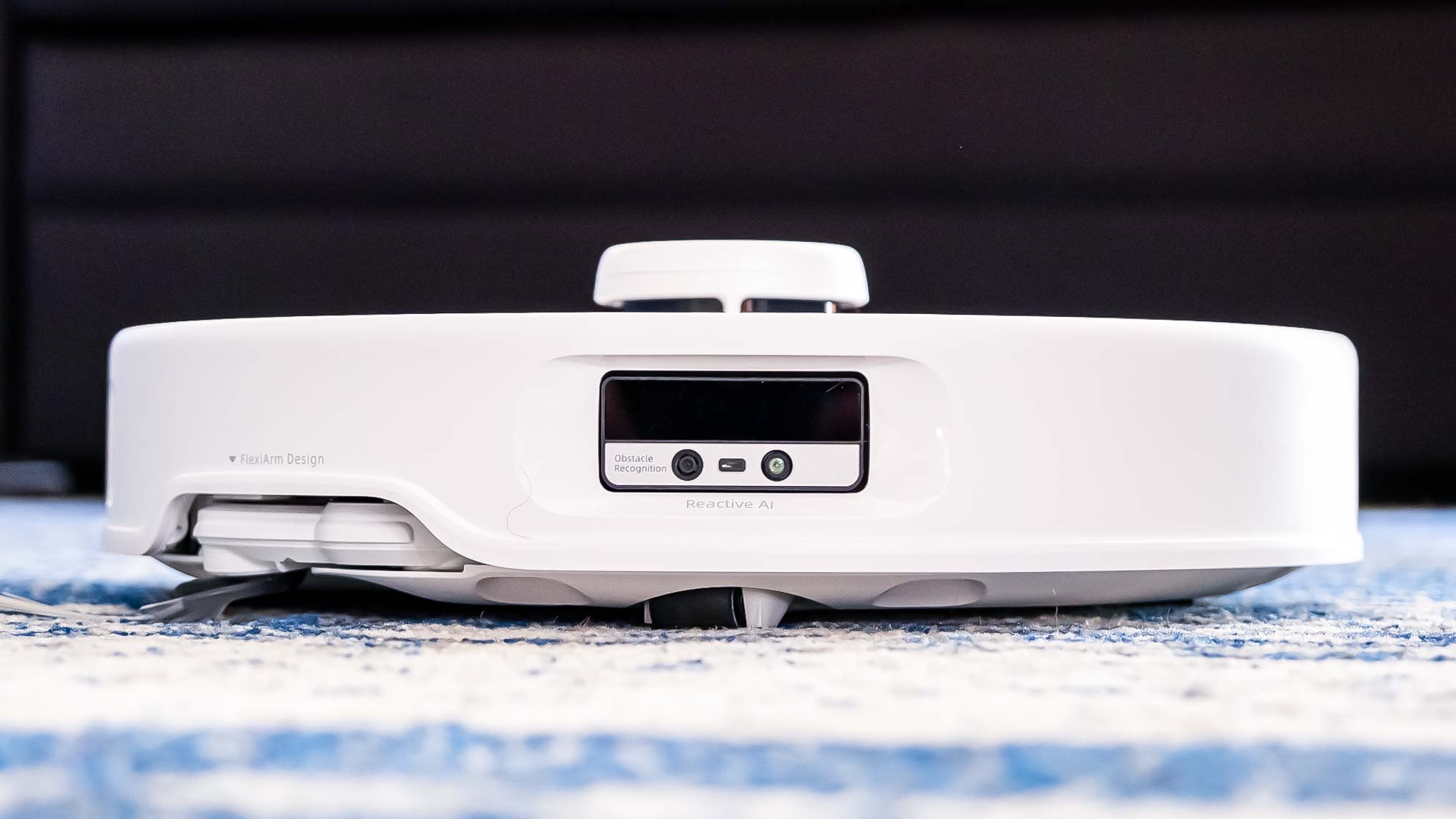
On top of the Qrevo Curv, two buttons can be found, one of which is a power button, and the other a home button. Notably missing compared to other Roborock vacuums is a spot clean button. However, you can, of course, simply use the app to initiate a spot clean.

On the bottom of the vacuum, you'll find the new DuoDivide Main Brush, which is a split brush that’s designed specifically to spiral hair towards a gap in the middle, then sucking it into the dustbin. As someone who lives with a wife with thick hair, I was particularly excited about this feature, and it seemed to work well during the testing period. You’ll also find the mop pads, which can lift when the Qrevo Curv is performing a vacuum-only clean, or when it’s cleaning carpet.
Roborock Qrevo Curv review: Vacuuming performance
Put simply, the Roborock Qrevo Curv sucks. In a good way, of course. The vacuum excelled in most of our tests, with one major exception.
Performance results:
| Row 0 - Cell 0 | Overall Score | Cereal | Kitty Litter | Dog Hair |
| Roborock Qrevo Curv | 94.5 | 99.9 | 99.9 | 83.6 |
| Shark PowerDetect 2-in-1 | 94.6 | 99.8 | 91.5 | 92.5 |
| Roborock S7 MaxV Ultra | 91.26 | 99.8 | 95.73 | 78.25 |
| Roomba s9+ | 96.82 | 92.5 | 100 | 98 |
Put simply, the Roborock Qrevo Curv sucks. In a good way, of course. The vacuum excelled in most of our tests, with one major exception.
The vacuum performed very well on hardwood, achieving near-perfect scores in all three of our tests, and even beating out the best-performing vacuums we’ve tested, like the iRobot Roomba s9+ and Roborock S7 MaxV Ultra. The only exception to this rule was the dog hair test, where the vacuum still performed very well. In hardwood tests, it averaged better than very powerful competitors, like the Roborock S7 MaxV, it just couldn’t quite reach the near-total cleanup other vacuums offer.
Its average on the carpet wasn't quite as high, and that's due to one key test: the dog hair test. The vacuum really struggled to pick up dog hair from the carpet, seriously lowering its average overall. It performed very well in the other tests, though, and to be fair, the pet hair in a carpet is a very challenging test — but one the best robot vacuums for pet hair pass more easily.
Hardwood floor results:
| Cheerios | Dog hair | Kitty litter | |
| Hardwood | 100% | 99.2% | 100% |
In both the cereal and kitty litter tests on hardwood, the vacuum scored essentially 100%. I watched it clean and found no trace of Cheerios after it was done on the hard floors. While I was able to scrounge together two tiny kitty litter pebbles, they didn't even register on a scale, essentially equating to the vacuum scoring 100% – though perhaps a more accurate score might be 99.999%. The side brush effectively pushed objects into the main brush, which easily sucked things up, even when it came to smaller fragments like Cheerio crumbs from full Cheerios being crushed under the wheels as the vacuum went. The vacuum didn’t pick up all of the dog hair in our test, but it did pick up the vast majority of it. When it comes to dog hair, it’s a bit middle-of-the-road amongst the top competitors, but again, it certainly still made it hard to tell there was ever dog hair there in the first place.
Carpet test results:
| Cheerios | Pet hair | Kitty litter | |
| Carpet | 99.9% | 68% | 99.9% |
When it came to small objects and dust, the vacuum performed very well on carpet too. Like on hardwood, it had no trouble picking up Cheerios and kitty litter, and while it didn’t score 100% on carpet like it did on hardwood, it did get very close, reaching 99.9% on both. The big challenge for this vacuum, however, came from dog hair. For whatever reason, despite the extremely high suction power, it really struggled in this test, picking up almost 70%, but nowhere near the top competitors that can get 90% or more. As such, there are other vacuums that perform much better on carpet when it comes to pet hair, like the iRobot Rooba s9+, which is the best-performing vacuum when it comes to carpet, and the Shark PowerDetect 2-in-1. That said, keep in mind that our tests are designed to push a vacuum to its limits, and frankly, it should still do just fine if you regularly vacuum up small amounts of stray pet hair, rather than huge amounts all at once. Despite this, overall, the vacuum performed well on carpet, and if you don’t have a pet and don’t need it to pick up pet hair, you’ll find that it excels.
Roborock Qrevo Curv review: Mopping performance
The Qrevo Curv steps things up a little in terms of its mopping performance compared to other Roborock vacuums. Traditionally, robotic vacuums have simply had a fabric pad on the bottom that they use for mopping, but that's changing as manufacturers attempt to compete by improving mopping performance overall. Rather than a simple fabric pad on the bottom, the Qrevo Curv has two spinning mop pads that can better reach into corners, ensuring that mopping is more effective. In fact, not only can the side brush extend with Roborock's so-called FlexiArm technology, but the mop pad on the right side of the vacuum can, too, giving it better reach.
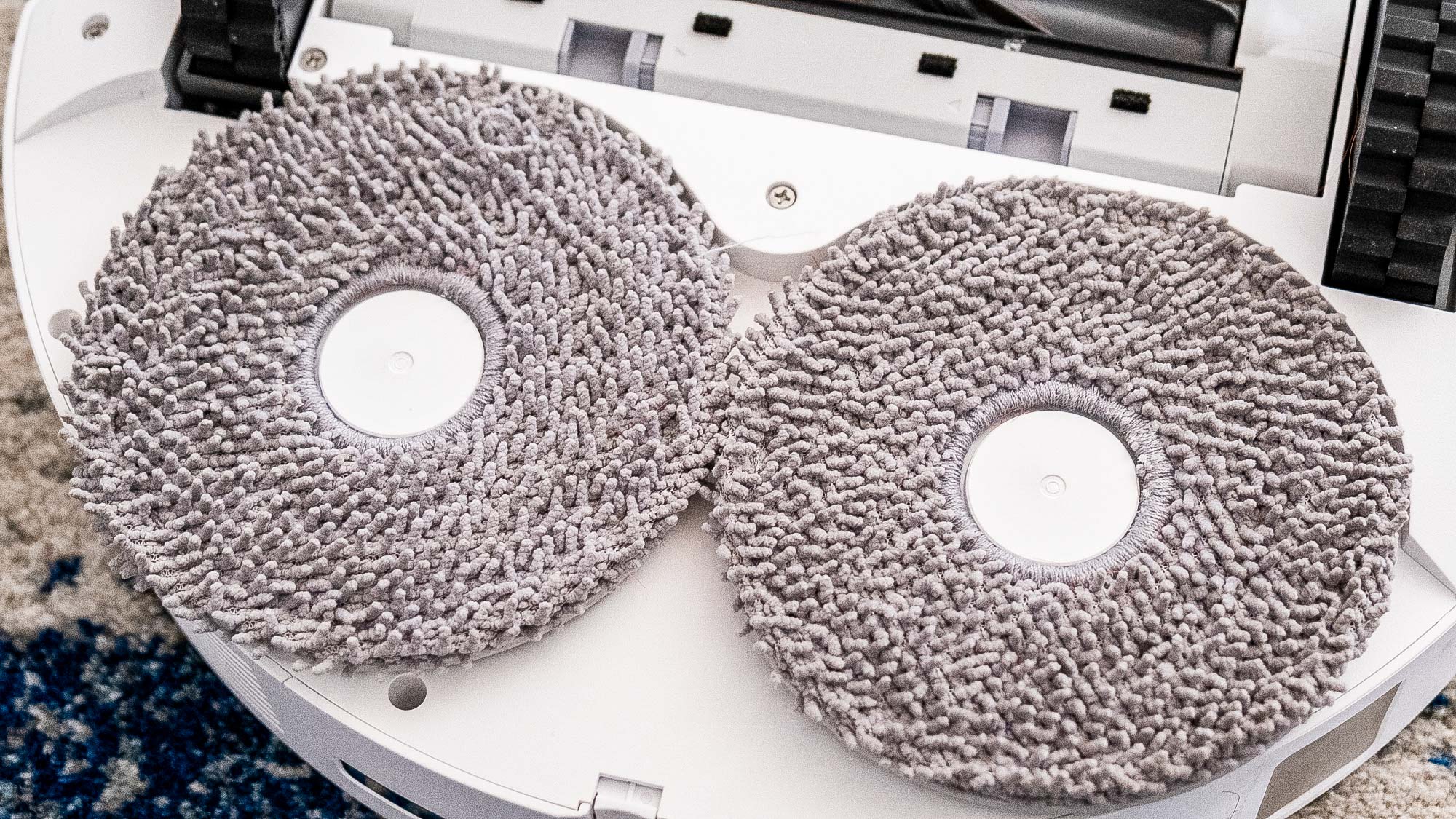
Like some other robotic vacuums, including other Roborock vacuums, the Qrevo Curv also works with a cleaning solution. This is a welcome trend over the past few years. Previous generation robotic vacuums couldn't work with cleaning solutions without risking damage to internal components, but that has been changing. Roborock sells its own floor cleaner that can be added to the clean water tank in the dock. You can get it from Amazon for $18.99, and Roborock advises adding one part cleaner to 300 parts water. When it comes to the Qrevo Curv, I measured around 125oz, so a little 0.5oz of solution should be added to a full tank of water.
Generally speaking, the Qrevo Curv performed quite well in mopping performance. It was able to clean up deliberate spills of things like hummus and red sauce, along with some more stuck-on stains from day-to-day use in a kitchen. And, it seemed to perform better than the robotic vacuum I was using previously, the Roborock S7 MaxV. I won’t be removing my weekly “spot clean the kitchen floors” reminder just yet, and you're not going to want to send your vacuum to clean up Kevin from The Office’s spilled chili, but it will take the day-to-day mopping out of the equation, which is helpful.
Like some other modern robotic vacuums, the Roborock Qrevo Curv will take care of cleaning the mop maps for you, which is very helpful. Speaking of reminders, I haven’t had a “put the mop pad in the laundry” reminder on my list for a few years now. It’ll essentially use the same clean water that it uses to mop the floors, to clean the mop pads in the docking station, after mopping the floors. For larger cleans, you may find that it returns to the dock to wash the mop pads halfway through the clean, but it only takes a few minutes, and it’s worth ensuring that it’s not mopping the floors with filthy pads. The dirty water that results from the mop pad cleaning is sucked into a dirty water bin, which you’ll need to empty every now and then – though how often depends on the size of your home and how regularly you clean it. I found that when cleaning a 560-square-foot space once per week, I had to empty it around once per month. It doesn’t fill up as quickly as the clean water tank empties over time, but for the sake of ease I just empty the dirty water whenever I refill the clean water.
Roborock Qrevo Curv review: Setup, app and mapping
Setting up the Roborock Qrevo Curv is relatively simple, but even if you have experience setting up robotic vacuums, it may take a few minutes to get everything up and running. You'll start by unpacking it and setting up the dock, including installing any uninstalled pieces, like the removable mop cleaning insert. You'll then install the mop pads on the vacuum itself and turn everything on, after which you'll be guided through instructions on how to get it set up in the app. Set up in the app will simply involve creating an account if you don't already have one, scanning a QR code, and connecting the vacuum to Wi-Fi. The entire process took me around 20 minutes.
You'll then be able to have the vacuum perform a “quick map” of your home. I found it to do so very quickly and quietly, mapping a 560-square-foot space in only around five minutes. After it finished mapping, it did a pretty good job at labeling the different rooms, too, seemingly picking up on things like a toilet to indicate a bathroom, and a couch for a living room. For the rooms it can't identify, it will just label them as "room," but you can rename them if you want.

You can also create your own so-called “rooms.” For example, there's a corner in my living room where the cat litter is, and I want my robot vacuum to clean this area every morning. Separating them into rooms allows me to schedule this to happen automatically. And, my living room and dining room are combined into one big living area, but I simply placed a line between them to differentiate the two spaces so that I could more specifically set up cleaning – something that needs to happen more regularly in the dining area after attempting to feed our 9-month-old baby.
During mapping, the vacuum won't really distinguish between hard floors and carpets unless it happens to run over a carpet while getting a layout of your home. It will, however, create a more specific look at the different surfaces when it does its first clean.
Of course, the app is comprehensive enough that you don't necessarily have to split all the different areas of your home into what the app calls rooms – but you will have to use rooms to create schedules. You can set up zones too, but zones are designed for one-time cleans, and those zones won’t be saved after that clean.
Like other robotic vacuums, you can have the Qrevo Curv vacuum, mop, or both. You can choose from five levels of suction power and three water flow presets and have the vacuum clean once over or twice over. You can actually get more precise with water flow too, if you want, by setting a custom water flow level with a slider that has 30 steps. This is probably something you would want to use after finding that you want something in between two of the water flow presets – but I was perfectly happy with the “Medium” preset.
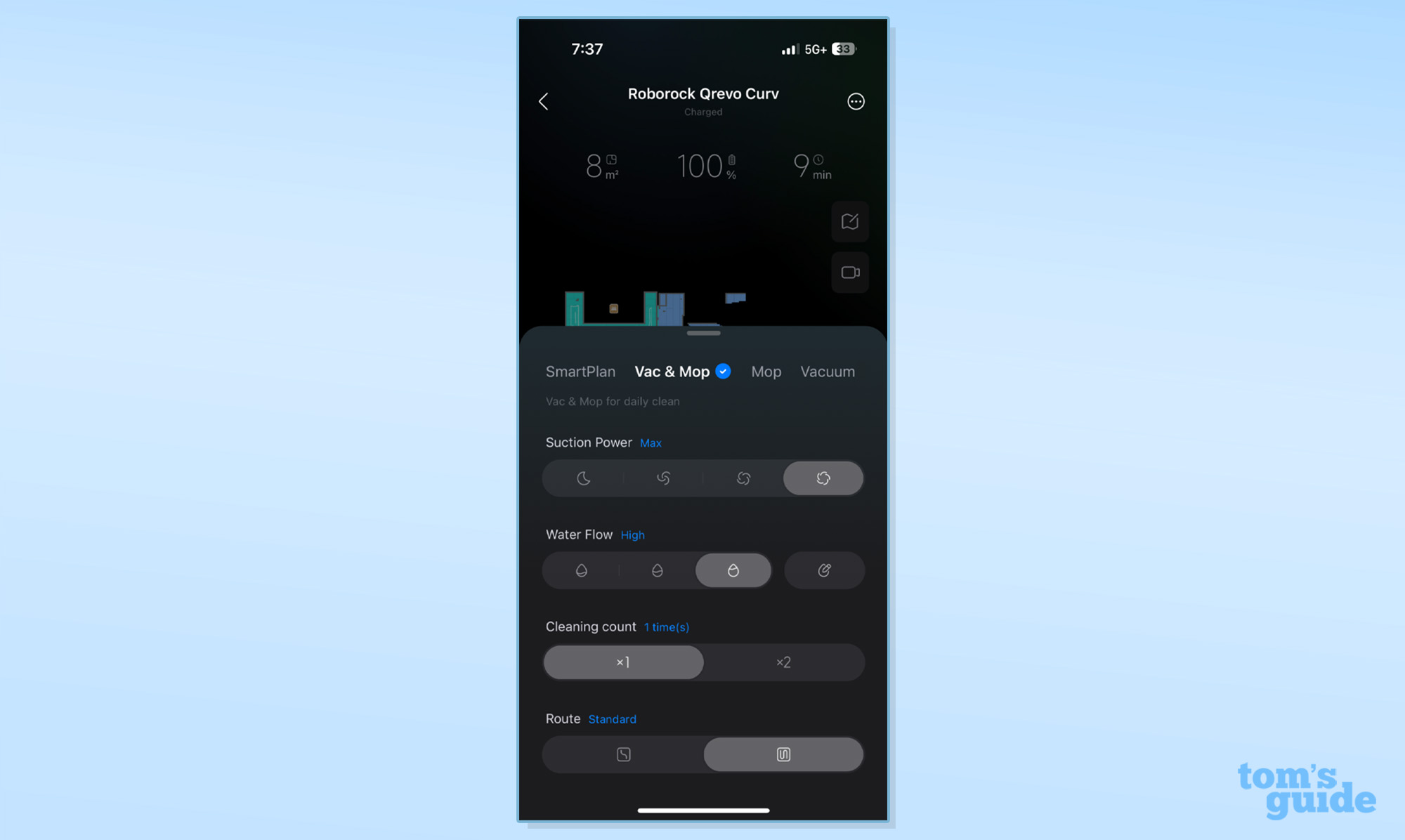
Unlike other robotic vacuums, however, the Qrevo Curv has a new SmartPlan AI-based feature, which will automatically detect the best cleaning levels based on the dirt levels it finds in your home. Beyond the idea of my robotic vacuum judging how dirty my home is, I found that this feature worked quite well and that everything looked relatively clean after a pass.
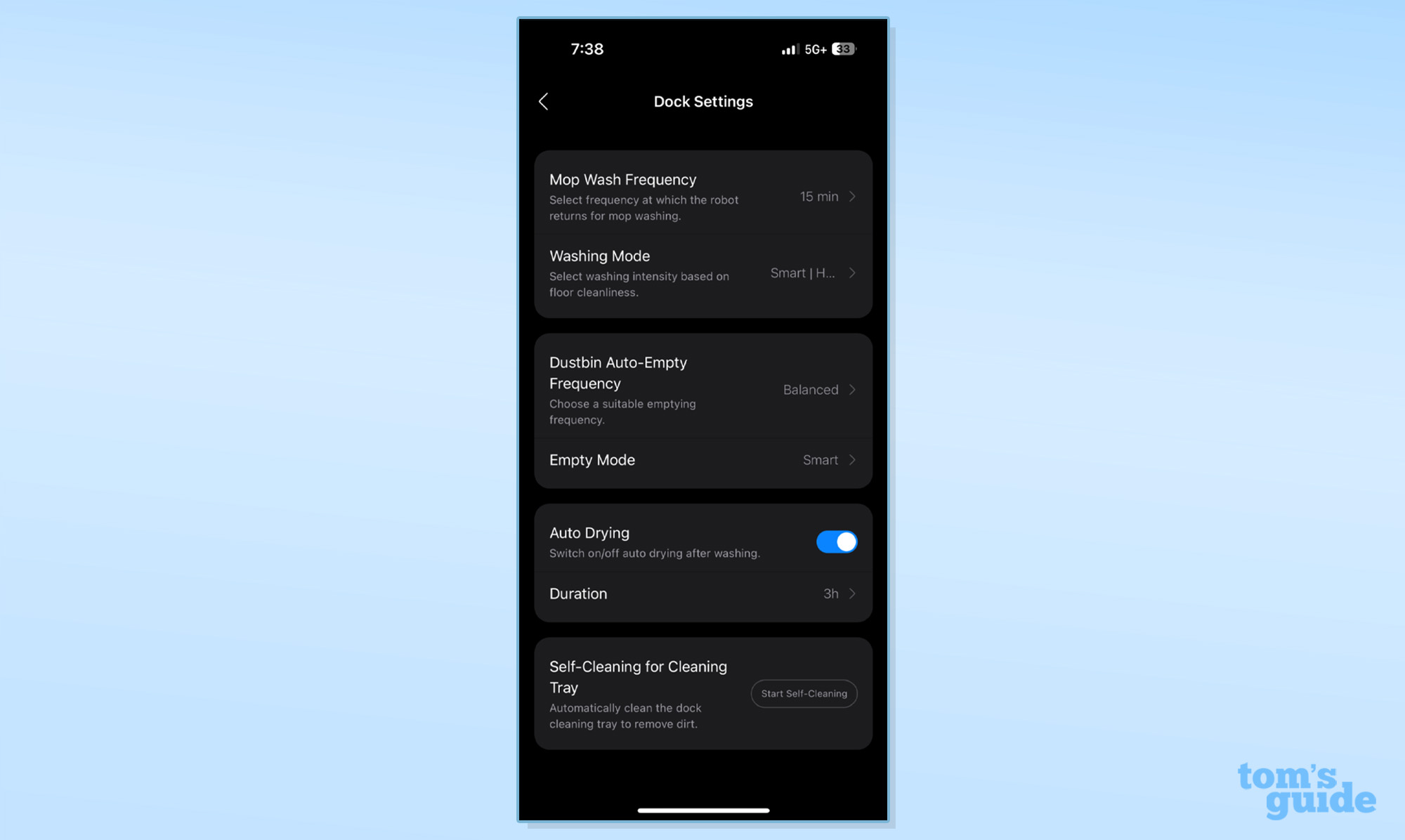
There are plenty of other settings that you can dive into through the app. There's a remote control feature that lets you manually control where the vacuum goes. There's also a maintenance feature that lets you see the status of things like the built-in filter, main brush, and side brush, allowing you to know better when they might need to be replaced. This vacuum also supports a remote viewing feature that lets you see where the vacuum is going through the cameras built into it. You'll have to manually enable this feature before a clean, and it will announce that it's viewing anytime you activate it for privacy reasons.
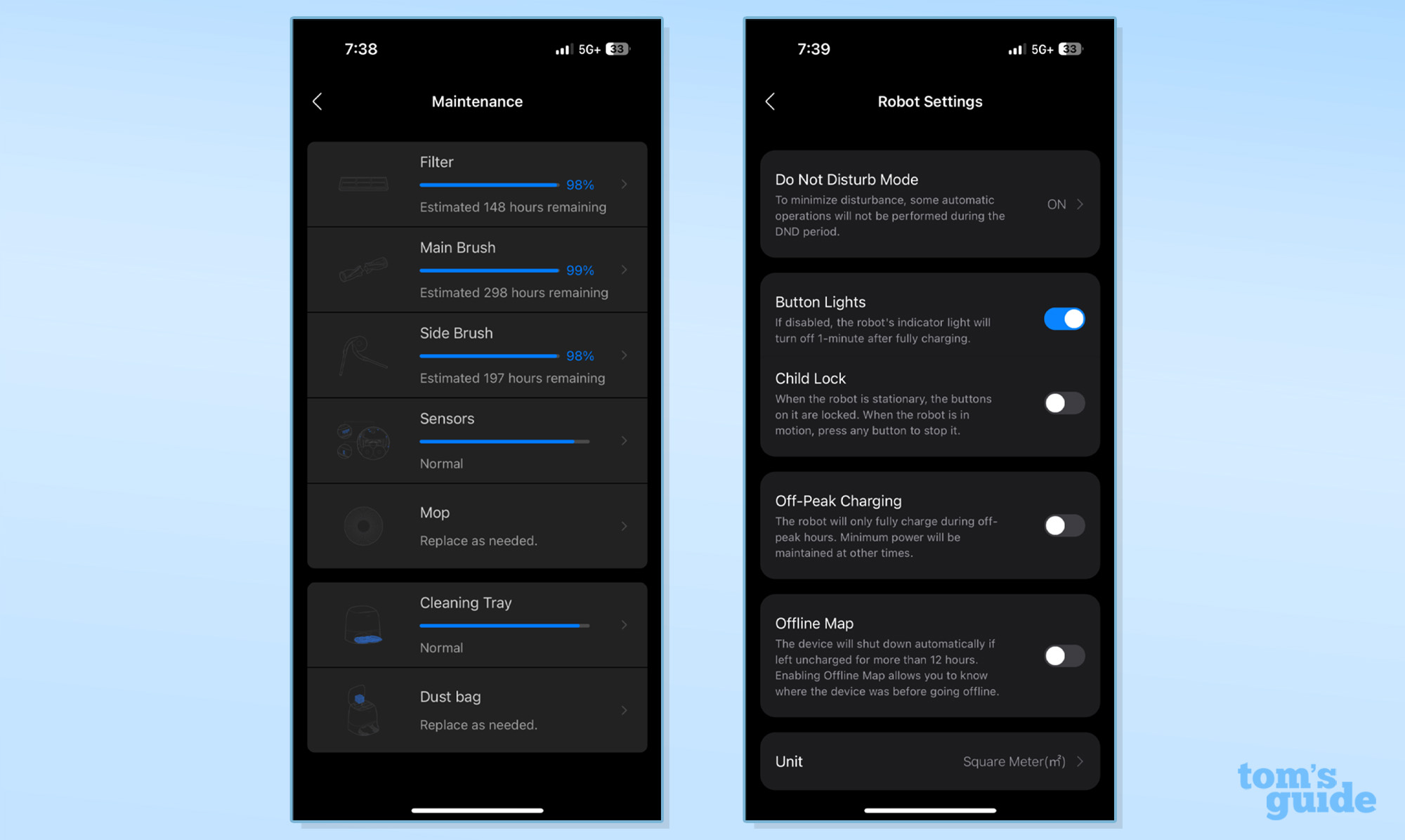
I found that the Qrevo Curv was excellent at avoiding and identifying obstacles, including charging cables. If enabled in the app, it can even take a picture of those obstacles for your viewing later, which can help you better set up your space to be easily cleaned.
Roborock Qrevo Curv review: Verdict
Despite its massive suction power, the Roborock Qrevo Curv didn’t necessarily blow every other product out of the water – but it still performed very well, and it is still an incredible product for the money. It's not Roborock's most expensive vacuum but it is its most powerful when it comes to suction – plus it happens to live in a slightly more stylish dock and works with the same well-designed app. It performs incredibly well on hardwood floors and very well on carpets, except when it needs to clean up excessive amounts of pet hair. That's not to mention the fact that it's very good mopping, and with the dock's to clean the mop pads, it requires very little upkeep.
But it's very expensive. At $1,599.99, it goes up against some of the best robot vacuums out there. Thankfully, it competes very well, beating out a large portion of the competition, especially when it comes to vacuuming up smaller hard objects, and mopping. It beat the Shark IQ, which is one of the best-performing vacuums we’ve tested, and the Shark PowerDetect, which is much cheaper, but currently rated as our top robotic vacuum. That’s not to mention the fact that it has better mopping performance than even the Roborock S7 MaxV Ultra. If you’re looking for top performing vacuuming and mopping, in a stylish design, the Roborock Qrevo Curv is for you – you’ll just have to pay quite a bit to get it.
Christian de Looper is a freelance writer who has covered every facet of consumer tech, including mobile, audio, home theater, computing, gaming, and even car tech. At Tom’s Guide, Christian covers TV and home theater tech, and has reviewed dozens of TVs, soundbars, and A/V receivers, including those from the likes of Samsung, Hisense, TCL, and Vizio.
You must confirm your public display name before commenting
Please logout and then login again, you will then be prompted to enter your display name.
